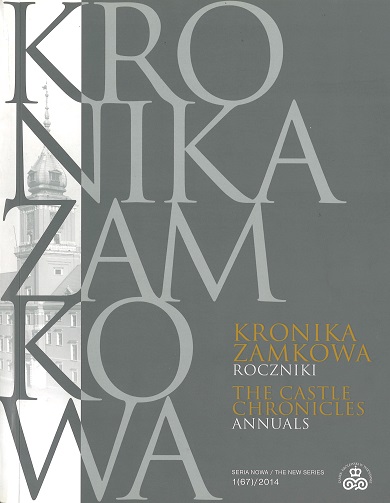Królewska maskarada, czyli rozwiązanie zagadki tzw. hiszpańskiego stroju koronacyjnego Stanisława Augusta
The Royal Masquerade, or Solving the Mystery of the Spanish Coronation Dress of Stanisław August
Author(s): Małgorzata Możdżynska-NawotkaSubject(s): Fine Arts / Performing Arts, History of Art
Published by: Arx Regia® Wydawnictwo Zamku Królewskiego w Warszawie – Muzeum
Keywords: Stanisław August Poniatowski; fashion; coronation dress; a Vandyke costume; Marcello Bacciarelli; Christoph Joseph Werner
Summary/Abstract: The article is concerned with the coronation dress of Poland’s last king Stanisław August Poniatowski depicted in his official portraits: the one painted by Christoph Joseph Werner soon after the ceremony in 1764 and especially the splendid portrait en habit de couronment which the King commissioned from Marcello Bacciarelli for the Marble Room of the Royal Castle in Warsaw (1767–1771). Both portraits show the newly crowned king not in the white pontifical robes he donned during the sacred act of coronation but in the clothes he changed into afterwards and wore during the following public celebration. Rather than selecting the Polish national costume, which would be regarded as appropriate and was expected of him, he chose the white satin suit trimmed with gold laces. In contemporary sources this costume was referred to as Spanish but so far it has remained a mystery what the word ‘Spanish’ really meant in this context and consequently what were the King’s reasons and motivations for selecting this attire. By pointing to analogies in Western painting and surviving garments in museum collections and by analysing contemporary witness accounts, the author identifies the king’s garb as a Vandyke costume, the type of historical fancy dress which had originated in England and was also popular in France where it was often worn with a ruff and called Spanish.’ It is also argued that this costume was selected by the King, quite extravagantly, considering the occasion, for related aesthetic, ideological-cum-political, and personal reasons. It looked up to the tradition of Rubens and Van Dyke, whose art the King knew and admired. The monarch’s personal contacts with Madame Geoffrin, the famous Parisian hostess who had played an instrumental role in promoting the ‘Spanish’ costume on the French art scene, likely influenced his choice. The plumed hat with the characteristic black and white feathers, which is not featured in the above mentioned portraits but appears in a later portrait by Bacciarelli, was part of the original coronation dress providing a specific and meaningful reference to Henry IV, King of France, whom Stanisław August admired and tried to emulate as the paramount of regal virtues and the model of enlightened and tolerant ruler. Cosmopolitan, rooted in Western artistic and courtly tradition, the King’s coronation dress presented a deliberate departure from the Polish national costume, which he was expected to adopt but refused to and the traditional values it represented. On a personal and psychological level, handsome and rather proud of his appearance, Stanisław August was reportedly very well aware of the costume showing off his assets splendidly. He regarded Bacciarelli’s painting depicting him in this picturesque garb as his most faithful portrait. The King’s behavior while parading in the Spanish dress on the streets of Warsaw, especially the theatrical manner of presentation and exaggerated courtesy towards ladies, recalled the spirit of courtly fêtes galantes of which similar costumes were characteristic. It seems that the Vandyke costume (or costume à la Henri IV) made its first public appearance in Poland at a very special historical moment and in quite unusual circumstances, an eloquent sign of the newly crowned King’s willingness to break off from tradition and, presumably, reform the state as King Henry IV had done. This kind of fancy dress would subsequently be adopted at the court, particularly by the ladies of artistic taste who sympathized with the King’s policies. The author identifies a number of male and female portraits showing variations of this costume, which would retain its relevance throughout the reign of Stanisław August. The theme would conclude, poignantly and melancholically, with his portrait in the costume of Henry IV painted by Élisabeth-Louise Vigée Le Brun in St Petersburg in 1797, already after the abdication of Stanisław August and shortly before his death in exile.
Journal: Kronika Zamkowa. Roczniki
- Issue Year: 1/2014
- Issue No: 1
- Page Range: 133-148
- Page Count: 16
- Language: Polish

